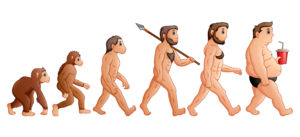
Human Evolution
“Paleo” is short for “Paleolithic” and refers to a diet similar to one our cavemen-ancestors would have eaten. A Paleo diet eliminates processed foods, sugars, dairy and grains and is reputed to help shed unwanted pounds, reduce inflammation and give you steady energy all day long. Find out how to live a Paleo life by reading more.
How Do I Eat a Paleo Diet?
Eat this:
- Lean cuts of meat—try to purchase organic, grass-fed or free-range options. This inlcudes beef, pork, and poultry.
- Remember game animals, such as quail, venison, and bison
- Eggs, but no more than six a week, and preferably free-range
- Fish, including shellfish
- Fruit—strawberries, cantaloupe, mango, and figs
- Non-starchy vegetables—asparagus, onions, peppers, and pumpkin
- Nuts and seeds—almonds, cashews, walnuts, and pumpkin seeds
- Olive oil, flaxseed oil, and walnut oil, in moderation
Not this:
- Dairy products– milk, cheese, yogurt, and butter
- Cereal grains—wheat, rye, rice, and barley
- Legumes– beans, peanuts, and peas
- Starchy vegetables– potatoes
- Sweets—candy, but also honey and sugar
- Artificial sweeteners
- Soft drinks and fruit juices
- Processed and cured meats—that includes bacon (!!), deli meats, and hot dogs
- Highly processed foods
But Does it Work?
Experts are mixed on whether eating a Paleo diet is effective. According to the University of Berkeley’s, Berkeley’s Wellness, “Paleo diet plans do have some good aspects. They rule out junk foods and added sugars, and cut way down on salt. They emphasize nutrient-rich, high-fiber fruits, vegetables and nuts. But they also rule out some healthy foods, such as whole grains, dairy products and beans.”
What seems most important is finding a healthy eating plan that works for you. While Berkeley suggests grains and dairy are healthy, they are only healthy for people who are not gluten-intolerant or lactose-intolerant. Be sure you know yourself and what foods make you feel good and what foods adversely affect you. In order to know how your body reacts to certain foods, consider abstaining from a particular food, like grains, then reintroducing that food back into your diet. Leave the food out of your diet for three to four weeks. Notice how you feel without the food. Reintroduce the food and notice your reaction. Increased heart rate, sore joints, skin breakouts could all be signs that your body is reacting to this food.
Learn what works for you, then actively work to find ways to enjoy the foods that work for you. That’s the key to a healthy diet.





